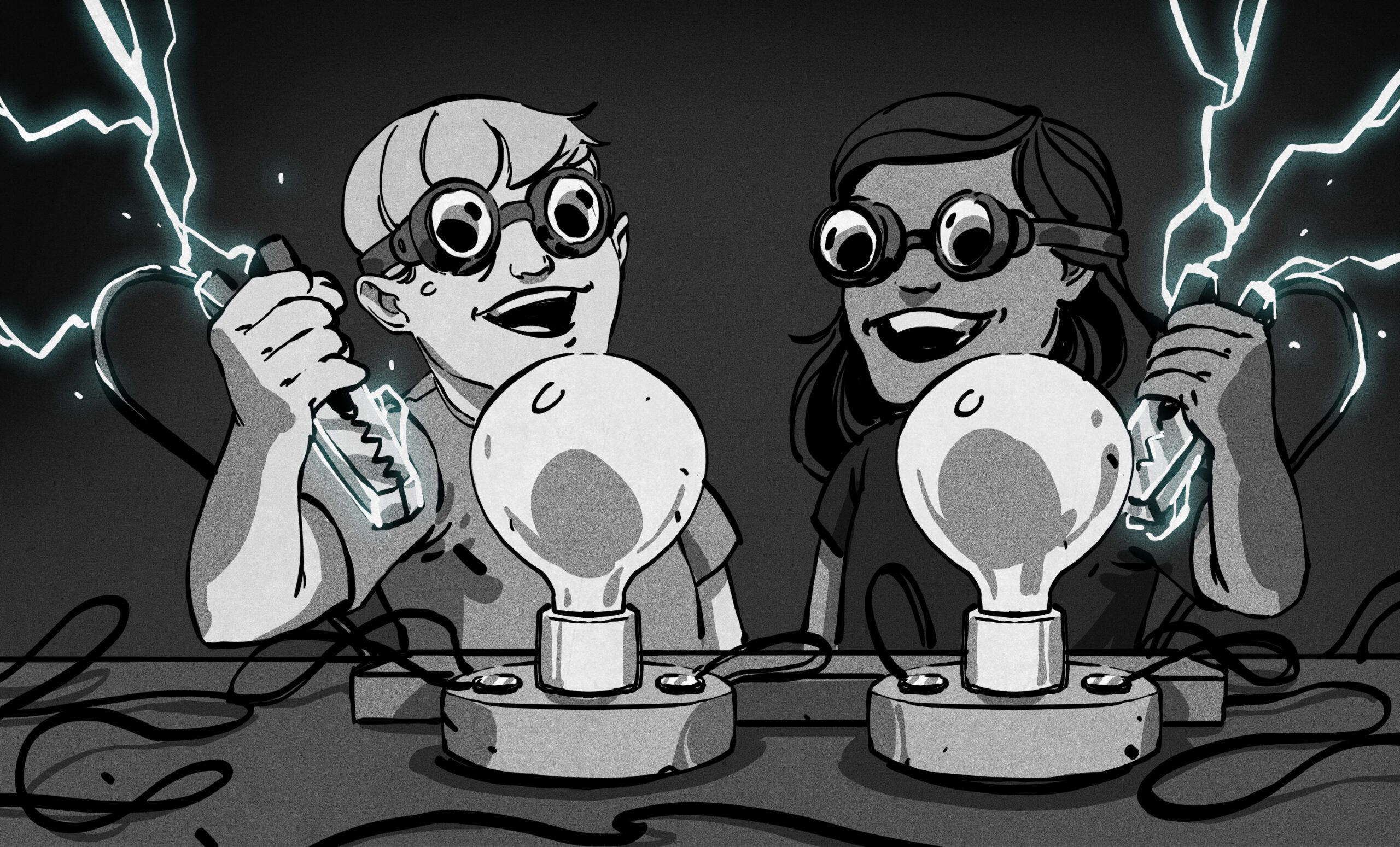Static electricity often just seems like an everyday annoyance when a wool sweater crackles as you pull it off, or when a doorknob delivers an unexpected zap. Regardless, the phenomenon is much more fascinating and complex than these simple examples suggest. In fact, static electricity is direct observable evidence of the actions of subatomic particles and the charges they carry.
While zaps from a fuzzy carpet or playground slide are funny, humanity has learned how to harness this naturally occurring force in far more deliberate and intriguing ways. In this article, we’ll dive into some of the most iconic machines that generate static electricity and explore how they work.
What Is It?
Before we look at the fancy science gear, we should actually define what we’re talking about here. In simple terms, static electricity is the result of an imbalance of electric charges within or on the surface of a material. While positively-charged protons tend to stay put, electrons, with their negative charges, can move between materials when they come into contact or rub against one another. When one material gains electrons and becomes negatively charged, and another loses electrons and becomes positively charged, a static electric field is created. The most visible result of this is when those charges are released—often in the form of a sudden spark.
Since it forms so easily on common materials, humans have been aware of static electricity for quite some time. One of the earliest recorded studies of the phenomenon came from the ancient Greeks. Around 1000 BC, they noticed that rubbing amber with fur would then allow it to attract small objects like feathers. Little came of this discovery, which was ascribed as a curious property of amber itself. Fast forward to the 17th century, though, and scientists were creating the first machines designed to intentionally store or generate static electricity. These devices helped shape our understanding of electricity and paved the way for the advanced electrical technologies we use today. Let’s explore a few key examples of these machines, each of which demonstrates a different approach to building and manipulating static charge.
The Leyden Jar
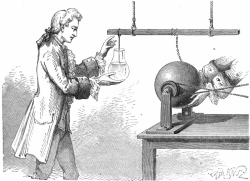
Though not exactly a machine for generating static electricity, the Leyden jar is a critical part of early electrostatic experiments. Effectively a static electricity storage device, it was independently discovered twice, first by a German named Ewald Georg von Kleist in 1745. However, it gained its common name when it was discovered by Pieter van Musschenbroek, a Dutch physicist, sometime between 1745 and 1746. The earliest versions were very simple, consisting of water in a glass jar that was charged with static electricity conducted to it via a metal rod. The experimenter’s hand holding the jar served as one plate of what was a rudimentary capacitor, the water being the other. The Leyden jar thus stored static electricity in the water and the experimenter’s hand.
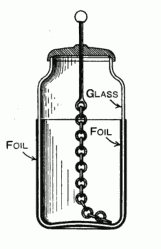
Eventually the common design became a glass jar with layers of metal foil both inside and outside, separated by the glass. Early experimenters would charge the jar using electrostatic generators, and then discharge it with a dramatic spark.
The Leyden jar is one of the first devices that allowed humans to store and release static electricity on command. It demonstrated that static charge could be accumulated and held for later use, which was a critical step in understanding the principles that would lead to modern capacitors. The Leyden jar can still be used in demonstrations of electrostatic phenomena and continues to serve as a fascinating link to the history of electrical science.
The Van de Graaff Generator
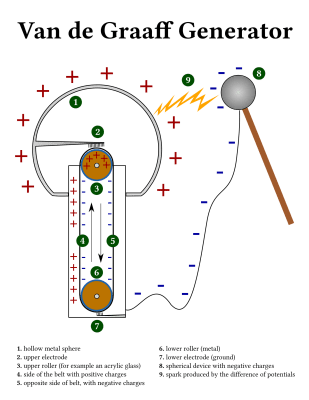
Perhaps the most iconic machine associated with generating static electricity is the Van de Graaff generator. Developed in the 1920s by American physicist Robert J. Van de Graaff, this machine became a staple of science classrooms and physics demonstrations worldwide. The device is instantly recognizable thanks to its large, polished metal sphere that often causes hair to stand on end when a person touches it.
The Van de Graaff generator works by transferring electrons through mechanical movement. It uses a motor-driven belt made of insulating material, like rubber or nylon, which runs between two rollers. At the bottom roller, plastic in this example, a comb or brush (called the lower electrode) is placed very close to the belt. As the belt moves, electrons are transferred from the lower roller onto the belt due to friction in what is known as the triboelectric effect. This leaves the lower roller positively charged and the belt carrying excess electrons, giving it a negative charge. The electric field surrounding the positively charged roller tends to ionize the surrounding air and attracts more negative charges from the lower electrode.
As the belt moves upward, it carries these electrons to the top of the generator, where another comb or brush (the upper electrode) is positioned near the large metal sphere. The upper roller is usually metal in these cases, which stays neutral rather than becoming intensely charged like the bottom roller. The upper electrode pulls the electrons off the belt, and they are transferred to the surface of the metal sphere. Because the metal sphere is insulated and not connected to anything that can allow the electrons to escape, the negative charge on the sphere keeps building up to very high voltages, often in the range of hundreds of thousands of volts. Alternatively, the whole thing can be reversed in polarity by changing the belt or roller materials, or by using a high voltage power supply to charge the belt instead of the triboelectric effect.
The result is a machine capable of producing massive static charges and dramatic sparks. In addition to its use as a demonstration tool, Van de Graaff generators have applications in particle physics. Since they can generate incredibly high voltages, they were once used to accelerate particles to high speeds for physics experiments. These days, though, our particle accelerators are altogether more complex.

Van de Graaff generators can be quite small, like this version used by science educators. Credit: Jared C. Benedict, CC BY-SA 3.0

Westinghouse famously built a huge Van de Graaff generator in 1937 which it referred to as the Atom Smasher. Credit: public domain
The Whimsical Wimshurst Machine
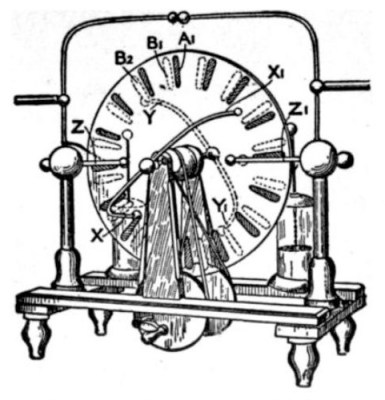
Another fascinating machine for generating static electricity is the Wimshurst machine, invented in the late 19th century by British engineer James Wimshurst. While less famous than the Van de Graaff generator, the Wimshurst machine is equally impressive in its operation and design.
The key functional parts of the machine are the two large, circular disks made of insulating material—originally glass, but plastic works too. These disks are mounted on a shared axle, but they rotate in opposite directions when the hand crank is turned. The surfaces of the disks have small metal sectors—typically aluminum or brass—which play a key role in generating static charge. As the disks rotate, brushes made of fine metal wire or other conductive material lightly touch their surfaces near the outer edges. These brushes don’t generate the initial charge but help to collect and amplify it once it is present.
The key to the Wimshurst machine’s operation lies in a process called electrostatic induction, which is essentially the influence that a charged object can exert on nearby objects, even without touching them. At any given moment, one small area of the rotating disk may randomly pick up a small amount of charge from the surrounding air or by friction. This tiny initial charge is enough to start the process. As this charged area on the disk moves past the metal brushes, it induces an opposite charge in the metal sectors on the other disk, which is rotating in the opposite direction.
For example, if a positively charged area on one disk passes by a brush, it will induce a negative charge on the metal sectors of the opposite disk at the same position. These newly induced charges are then collected by a pair of metal combs located above and below the disks. The combs are typically connected to Leyden jars to store the charge, until the voltage builds up high enough to jump a spark over a gap between two terminals.

The Wimshurst machine doesn’t create static electricity out of nothing; rather, it amplifies small random charges through the process of electrostatic induction as the disks rotate. As the charge is collected by brushes and combs, it builds up on the machine’s terminals, resulting in a high-voltage output that can produce dramatic sparks. This self-amplifying loop is what makes the Wimshurst machine so effective at generating static electricity.
The Wimshurst machine is seen largely as a curio today, but it did have genuine scientific applications back in the day. Beyond simply using it to investigate static electricity, its output could be discharged into Crookes tubes to create X-rays in a very rudimentary way.
The Electrophorus: Simple Yet Ingenious
One of the simplest machines for working with static electricity is the electrophorus, a device that dates back to 1762. Invented by Swedish scientist Johan Carl Wilcke, the electrophorus consists of two key parts: a flat dielectric plate and a metal disk with an insulating handle. The dielectric plate was originally made of resinous material, but plastic works too. Meanwhile, the metal disk is naturally conductive.

To generate static electricity with the electrophorus, the dielectric plate is first rubbed with a cloth to create a static charge through friction. This is another example of the triboelectric effect, as also used in the Van de Graaff generator. Once the plate is charged, the metal disk is placed on top of it. The disc then becomes charged by induction. It’s much the same principle as the Wimshurst machine, with the electrostatic field of the dielectric plate pushing around the charges in the metal plate until it too has a distinct charge.
For example, if the dielectric plate has been given a negative charge by rubbing, it will repel negative charges in the metal plate to the opposite side, giving the near surface a positive charge, and the opposite surface a negative charge. The net charge, though, remains neutral. But, if the metal disk is then grounded—for example, by briefly touching it with a finger—the negative charge on the disk can drained away, leaving it positively charged as a whole. This process does not deplete the charge on the dielectric, so it can be used to charge the metal disk multiple times, though the dielectric’s charge will slowly leak away in time.
Though it’s simple in design, the electrophorus remains a remarkable demonstration of static electricity generation and was widely used in early electrostatic experiments. A particularly well-known example is that of Georg Lichtenberg. He used a version a full two meters in diameter to create large discharges for his famous Lichtenberg figures. Overall, it’s an excellent tool for teaching the basic principles of electrostatics and charge separation—particularly given how simple it is in construction compared to some of the above machines.
Zap
Static electricity, once a mysterious and elusive force, has long since been tamed and turned into a valuable tool for scientific inquiry and education. Humans have developed numerous machines to generate, manipulate, and study static electricity—these are just some of the stars of the field. Each of these devices played an important role in furthering humanity’s understanding of electrostatics, and to a degree, physics in general.
Today, these machines continue to serve as educational tools and historical curiosities, offering a glimpse into the early days of electrical science—and they still spark fascination on the regular, quite literally. Static electricity may be an everyday phenomenon, but the machines that harness its power are still captivating today. Just go to any local science museum for the proof!
